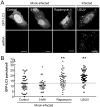Infection with Usutu virus induces an autophagic response in mammalian cells
- PMID: 24205422
- PMCID: PMC3812092
- DOI: 10.1371/journal.pntd.0002509
Infection with Usutu virus induces an autophagic response in mammalian cells
Abstract
Usutu virus (USUV) is an African mosquito-borne flavivirus closely related to West Nile virus and Japanese encephalitis virus, which host range includes mainly mosquitoes and birds, although infections in humans have been also documented, thus warning about USUV as a potential health threat. Circulation of USUV in Africa was documented more than 50 years ago, but it was not until the last decade that it emerged in Europe causing episodes of avian mortality and some human severe cases. Since autophagy is a cellular pathway that can play important roles on different aspects of viral infections and pathogenesis, the possible implication of this pathway in USUV infection has been examined using Vero cells and two viral strains of different origin. USUV infection induced the unfolded protein response, revealed by the splicing of Xbp-1 mRNA. Infection with USUV also stimulated the autophagic process, which was demonstrated by an increase in the cytoplasmic aggregation of microtubule-associated protein 1 light chain 3 (LC3), a marker of autophagosome formation. In addition to this, an increase in the lipidated form of LC3, that is associated with autophagosome formation, was noticed following infection. Pharmacological modulation of the autophagic pathway with the inductor of autophagy rapamycin resulted in an increase in virus yield. On the other hand, treatment with 3-methyladenine or wortmannin, two distinct inhibitors of phosphatidylinositol 3-kinases involved in autophagy, resulted in a decrease in virus yield. These results indicate that USUV virus infection upregulates the cellular autophagic pathway and that drugs that target this pathway can modulate the infection of this virus, thus identifying a potential druggable pathway in USUV-infection.
Conflict of interest statement
The authors have declared that no competing interests exist.
Figures








References
Publication types
MeSH terms
LinkOut - more resources
Full Text Sources
Other Literature Sources
Research Materials

